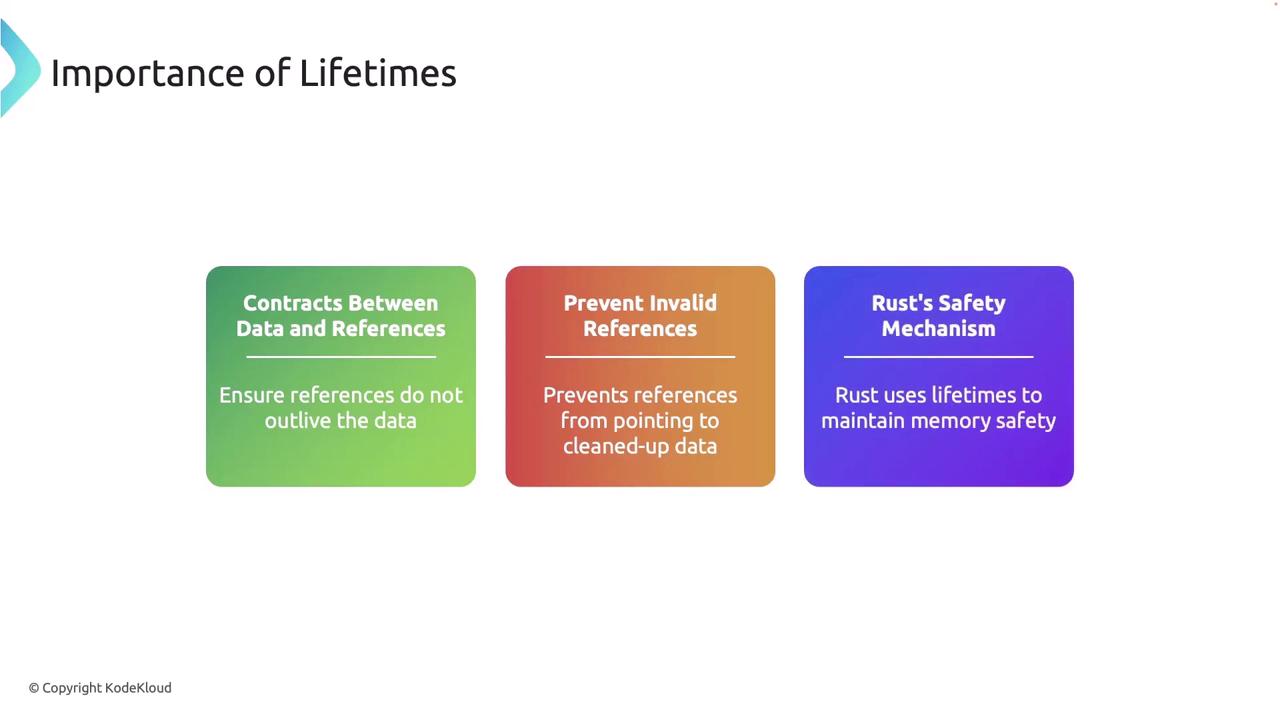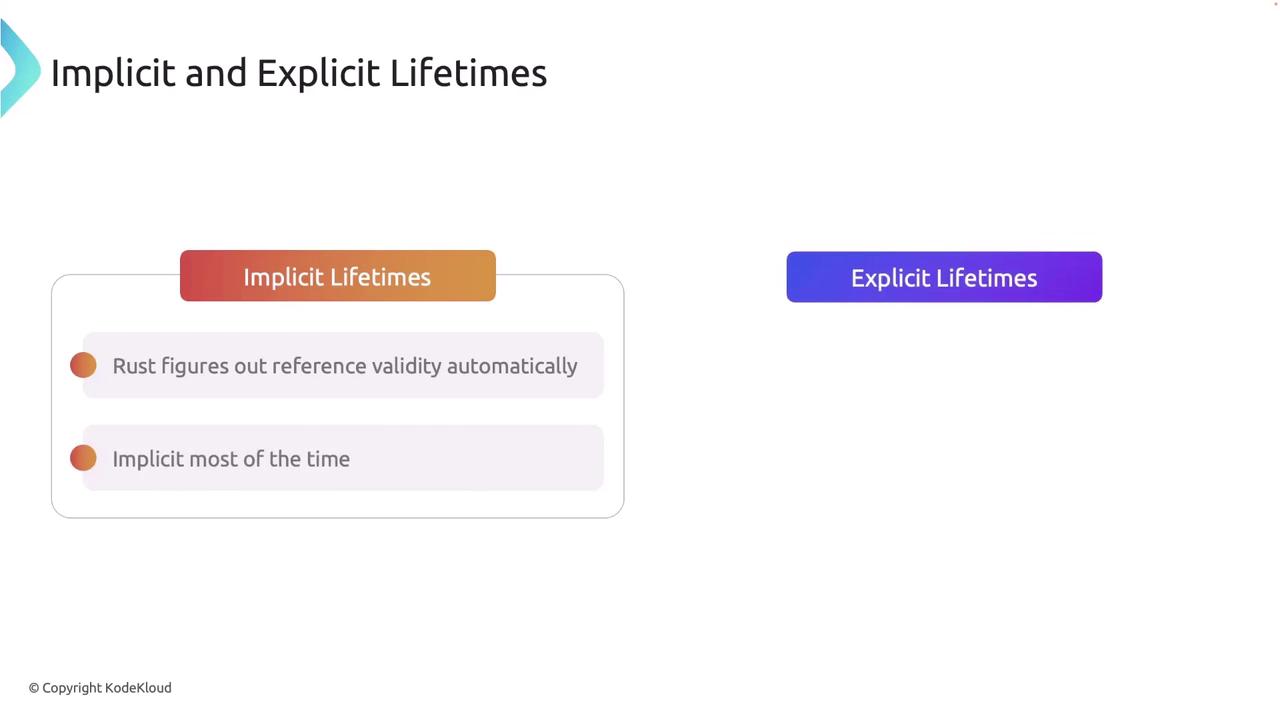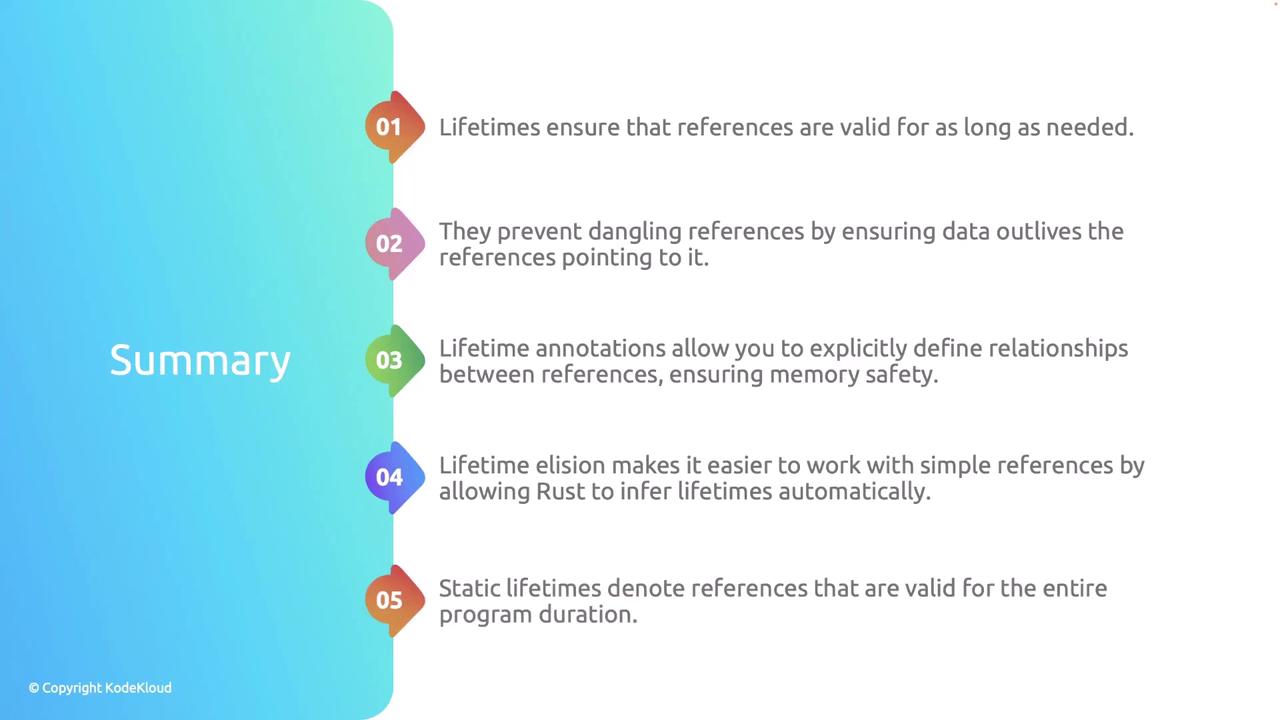Rust Programming
Advanced Rust Concepts
Validating References with Lifetimes
In this lesson, we delve into Rust lifetimes and understand why they are essential for maintaining memory safety. Lifetimes allow you to manage the duration for which references remain valid. Unlike many other languages, Rust strictly enforces reference validity, preventing issues such as dangling pointers where a reference might point to deallocated memory. Think of lifetimes as contracts: they ensure that no reference outlives the underlying data.
For instance, imagine borrowing a book from a library—you can only refer to it while it’s on loan. Once returned, any lingering reference becomes invalid. Rust enforces a similar guarantee by preventing references from outliving their associated data.

Most of the time, Rust can infer lifetimes automatically (implicit lifetimes). However, when multiple references are involved, explicit lifetime annotations are required to clearly define their relationships.

Basic Syntax of Lifetimes
Lifetimes are denoted using an apostrophe followed by a name (commonly a single letter like 'a). Consider the following example with two string slices. The function returns the longer slice using a lifetime annotation to indicate that both input references and the returned reference share the same lifetime:
fn longest<'a>(x: &'a str, y: &'a str) -> &'a str {
if x.len() > y.len() {
x
} else {
y
}
}
fn main() {
let string1: String = String::from("Hello");
let string2: &str = "Rust";
let result: &str = longest(string1.as_str(), string2);
println!("The longest string is {}", result);
}
In this example, the lifetime parameter 'a ensures that x, y, and the returned reference remain valid for the same period. Without these explicit annotations, Rust's compiler is unable to verify the returned reference's validity, leading to a compile-time error.
For example, the function below will produce an error:
fn longest(x: &str, y: &str) -> &str {
if x.len() > y.len() {
x
} else {
y
}
}
Compiling this code results in an error like:
cargo run --quiet
error[E0106]: missing lifetime specifier
--> src/main.rs:6:33
|
6 | fn longest(x: &str, y: &str) -> &str {
| ^ expected named lifetime parameter
help: consider introducing a named lifetime parameter
|
6 | fn longest<'a>(x: &'a str, y: &'a str) -> &'a str {
Note
The error highlights that the return type must explicitly tie the lifetimes of the input parameters to the returned reference to maintain memory safety.
Preventing Dangling References
One common programming pitfall is creating dangling references—pointers to data that no longer exists. Rust's ownership, borrowing rules, and lifetime annotations work together to prevent this issue.
Consider the following function that incorrectly attempts to return a reference to a local variable:
fn create_reference<'a>() -> &'a String {
let s: String = String::from("This string is temporary");
&s
}
Here, the variable s is deallocated when the function exits, and returning &s will create a dangling reference. Rust’s compiler detects this issue:
cargo run --quiet
error[E0515]: cannot return reference to local variable `s`
--> src/main.rs:5:5
|
5 | &s
| ^^ returns a reference to data owned by the current function
To resolve this, return the owned data instead, transferring ownership to the caller:
fn create_reference() -> String {
let s: String = String::from("This string is temporary");
s
}
fn main() {
println!("{}", create_reference());
}
This approach avoids dangling references by ensuring the calling context takes ownership of the data.
Lifetime Elision
Lifetime elision is a convenient feature in Rust that allows the compiler to infer lifetimes in simple functions, reducing the need for explicit annotations. For example, consider a function that returns the first word from a string slice:
fn first_word(s: &str) -> &str {
for (i, &item) in s.as_bytes().iter().enumerate() {
if item == b' ' {
return &s[0..i];
}
}
&s[..]
}
fn main() {
let sentence: String = String::from("Example of Lifetimes");
println!("The first word in '{}' is '{}'", sentence, first_word(&sentence));
}
Even without explicit lifetimes, Rust infers that the lifetime of the output is the same as that of s, ensuring memory safety while keeping the code concise.
The Static Lifetime
Rust provides a special lifetime, 'static, which signifies that a reference is valid for the entire duration of the program. For example, string literals have a static lifetime because they are embedded directly in the program binary and remain valid throughout program execution:
fn main() {
// String literal with a static lifetime
let greeting: &'static str = "Hello, world!";
// Global variable with a static lifetime
static MAX_LIMIT: i32 = 100;
}
Static lifetimes are useful for global constants and data that must persist for the entirety of the program’s runtime.
Summary
Lifetimes in Rust are vital to ensuring that references remain valid, thereby preventing common memory issues like dangling references. Key points include:
- Lifetimes serve as contracts between data and its references, ensuring references do not outlive the data they point to.
- Explicit lifetime annotations help clarify relationships between multiple references in functions.
- Lifetime elision allows Rust to infer lifetimes in simple cases, keeping code less verbose.
- The
'staticlifetime is used for data that is valid for the entire program duration such as string literals and global constants.

Watch Video
Watch video content
Practice Lab
Practice lab